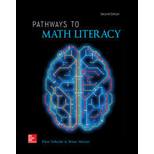
Carefully read through the list of terminology we’ve used in Unit 2. Consider circling the terms you aren’t familiar with and looking them up. Then test your understanding by using the list to fill in the appropriate blank in each sentence.
area
change
compound inequality
constant
conversion factor
dependent variable
dimensional analysis
empirical rule
equation
equivalent
error
estimation
evaluate
expected value
expression
fair game
formula
future value
greater than
greater than or equal to
independent variable
inequality
input
interest rate
less than
less than or equal to
mean
median
mode
output
percent error
principal
range
rate
relative change
standard deviation
time
unit rate
variable
volume
weighted scale
The independent variable is sometimes called the _______________ and the dependent variable is sometimes call the _______________.
Want to see the full answer?
Check out a sample textbook solution
Chapter 2 Solutions
Pathways To Math Literacy
- By considering appropriate series expansions, ex · ex²/2 . ¸²³/³ . . .. = = 1 + x + x² +…… when |x| < 1. By expanding each individual exponential term on the left-hand side and multiplying out, show that the coefficient of x 19 has the form 1/19!+1/19+r/s, where 19 does not divide s.arrow_forwardLet 1 1 r 1+ + + 2 3 + = 823 823s Without calculating the left-hand side, prove that r = s (mod 823³).arrow_forwardFor each real-valued nonprincipal character X mod 16, verify that L(1,x) 0.arrow_forward
- *Construct a table of values for all the nonprincipal Dirichlet characters mod 16. Verify from your table that Σ x(3)=0 and Χ mod 16 Σ χ(11) = 0. x mod 16arrow_forwardFor each real-valued nonprincipal character x mod 16, verify that A(225) > 1. (Recall that A(n) = Σx(d).) d\narrow_forward24. Prove the following multiplicative property of the gcd: a k b h (ah, bk) = (a, b)(h, k)| \(a, b)' (h, k) \(a, b)' (h, k) In particular this shows that (ah, bk) = (a, k)(b, h) whenever (a, b) = (h, k) = 1.arrow_forward
- 20. Let d = (826, 1890). Use the Euclidean algorithm to compute d, then express d as a linear combination of 826 and 1890.arrow_forwardLet 1 1+ + + + 2 3 1 r 823 823s Without calculating the left-hand side, Find one solution of the polynomial congruence 3x²+2x+100 = 0 (mod 343). Ts (mod 8233).arrow_forwardBy considering appropriate series expansions, prove that ez · e²²/2 . e²³/3 . ... = 1 + x + x² + · ·. when <1.arrow_forward
- Prove that Σ prime p≤x p=3 (mod 10) 1 Р = for some constant A. log log x + A+O 1 log x ,arrow_forwardLet Σ 1 and g(x) = Σ logp. f(x) = prime p≤x p=3 (mod 10) prime p≤x p=3 (mod 10) g(x) = f(x) logx - Ր _☑ t¯¹ƒ(t) dt. Assuming that f(x) ~ 1½π(x), prove that g(x) ~ 1x. 米 (You may assume the Prime Number Theorem: 7(x) ~ x/log x.) *arrow_forwardLet Σ logp. f(x) = Σ 1 and g(x) = Σ prime p≤x p=3 (mod 10) (i) Find ƒ(40) and g(40). prime p≤x p=3 (mod 10) (ii) Prove that g(x) = f(x) logx – [*t^¹ƒ(t) dt. 2arrow_forward
 Holt Mcdougal Larson Pre-algebra: Student Edition...AlgebraISBN:9780547587776Author:HOLT MCDOUGALPublisher:HOLT MCDOUGAL
Holt Mcdougal Larson Pre-algebra: Student Edition...AlgebraISBN:9780547587776Author:HOLT MCDOUGALPublisher:HOLT MCDOUGAL Glencoe Algebra 1, Student Edition, 9780079039897...AlgebraISBN:9780079039897Author:CarterPublisher:McGraw Hill
Glencoe Algebra 1, Student Edition, 9780079039897...AlgebraISBN:9780079039897Author:CarterPublisher:McGraw Hill Algebra: Structure And Method, Book 1AlgebraISBN:9780395977224Author:Richard G. Brown, Mary P. Dolciani, Robert H. Sorgenfrey, William L. ColePublisher:McDougal Littell
Algebra: Structure And Method, Book 1AlgebraISBN:9780395977224Author:Richard G. Brown, Mary P. Dolciani, Robert H. Sorgenfrey, William L. ColePublisher:McDougal Littell Elementary AlgebraAlgebraISBN:9780998625713Author:Lynn Marecek, MaryAnne Anthony-SmithPublisher:OpenStax - Rice University
Elementary AlgebraAlgebraISBN:9780998625713Author:Lynn Marecek, MaryAnne Anthony-SmithPublisher:OpenStax - Rice University Elementary Geometry For College Students, 7eGeometryISBN:9781337614085Author:Alexander, Daniel C.; Koeberlein, Geralyn M.Publisher:Cengage,
Elementary Geometry For College Students, 7eGeometryISBN:9781337614085Author:Alexander, Daniel C.; Koeberlein, Geralyn M.Publisher:Cengage, College Algebra (MindTap Course List)AlgebraISBN:9781305652231Author:R. David Gustafson, Jeff HughesPublisher:Cengage Learning
College Algebra (MindTap Course List)AlgebraISBN:9781305652231Author:R. David Gustafson, Jeff HughesPublisher:Cengage Learning





